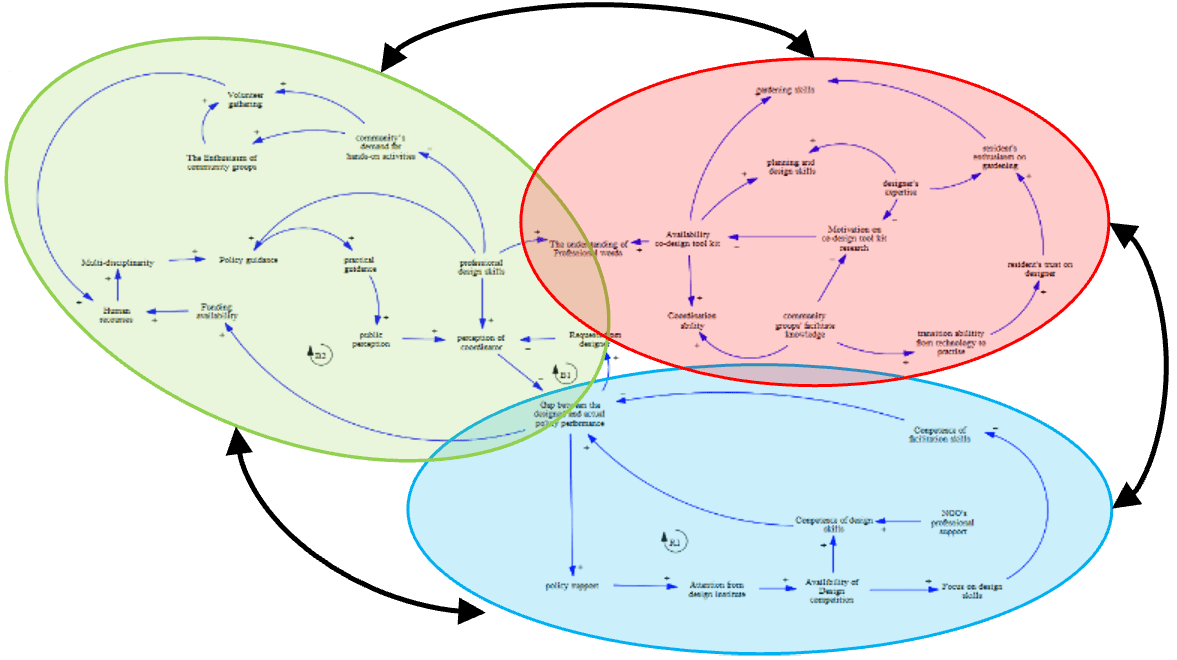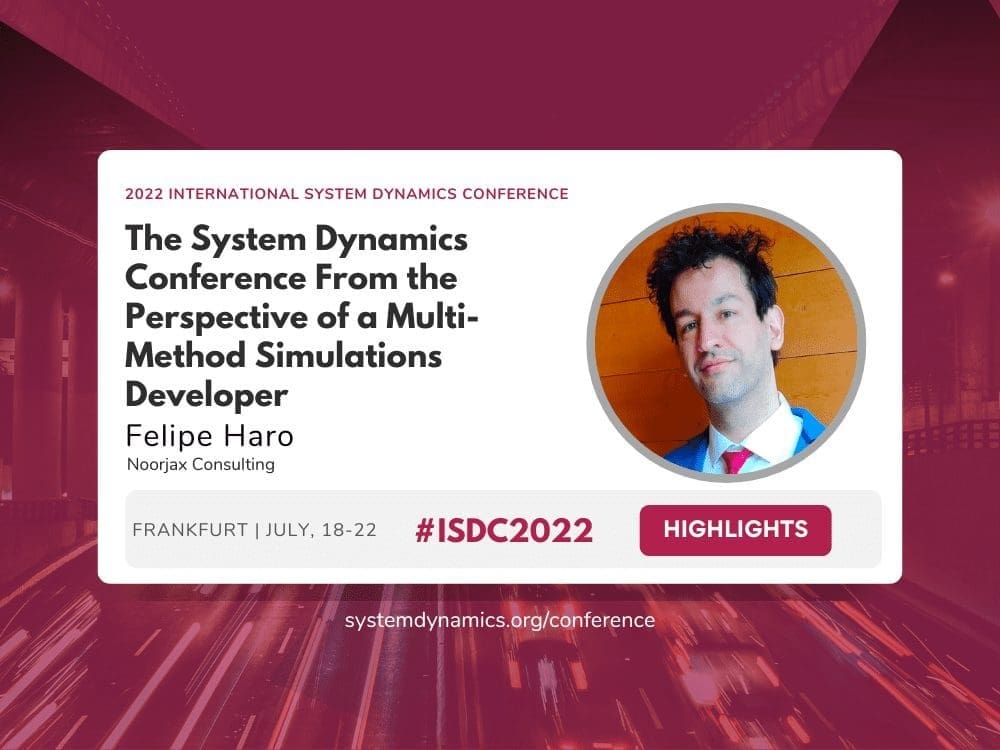The System Dynamics Conference From the Perspective of a Multi-Method Simulations Developer
System Dynamics, Agent-Based and Discrete-Event simulations are three competing and complementary simulation methods that are used to address a wide range of real-world problems. Each one of these has its pros and cons and can be applied better or worse depending on the context of the problem but can also be complementary in order to capture different pieces of the reality we want to simulate.
As System Dynamics seems to be an obscure topic for most discrete-event and agent-based modelers, the opposite is also true. And assuming good practices are in place, contrary to Agent-Based modeling guidelines, in System Dynamics, there is no standardized way in which a section of a model can be reutilized and the definition of what a sub-model or module is, depends largely on the context of the modeler. In other words, while in Agent-Based modeling, the sub-model is the agent itself, in System Dynamics, the sub-model can be a theme, an entity, a set of stocks that look good together, the importance of a sub-system, etc. A solution to this standard modularization problem, both in its qualitative and quantitative forms was discussed during this conference, in particular for Work-in-Progress sessions.
From a qualitative point of view, the presentation “Modelling the Complexity of Large Systems: A Network-aided System Dynamics Approach”, intends to use a method based on graph theory to identify themes within a complex network of causal relationships. Each theme can be approached separately by the subject matter expert that is associated with that theme, while also helping define boundaries for future work to be developed (see Figure 1). This is a great approach because it highlights the themes and transforms eventually this complicated network into a well-designed Causal Loop Diagram, with clear sections that are easy to read and understand. Looking at these themes, to a multi-method simulations developer, it appears that these themes are very closely related to the concept of an agent.

Figure 1: Social network of themes and causal loop diagram of selected themes
(Wang, Zimmermann: Modelling the Complexity of Large Systems: A Network-aided System Dynamics Approach, 2022 International System Dynamics Conference, figure used with permission.)
From a quantitative perspective, in their workshop “Using a Tool to Professionalize Model development” Copernicos showed a tool that attempts to improve the structure of a model by creating entities that represent certain hidden topics in models, mostly looking at dimensions and subscripts (or arrays), and generating modules in Stella or sub-models in Vensim that represent what they call hidden topics. This is done with an Excel plugin that acts as a transformation interface that reads the model and generates a new model that is organized with the concept of entities. The arrays are still there as defined by the modeler, but the way the model is organized in modules (in Stella) or sub-models (in Vensim) becomes very similar to what an agent would be in agent-based modeling or to what an entity would be in Ventity. In my opinion, this is a great approach since it goes in the direction of standardizing the modularization of a big complex model, which is the topic we are discussing in this article.
In the multi-method framework, mostly used by AnyLogic developers, it is common to solve these problems by having Agent-Based/System-Dynamics hybrids, in which modules or arrays are replaced by the concept of agent. From the qualitative side, having agents as part of the conceptual framework greatly helps build a hierarchical network of reusable modules that represent the system that needs to be conceptualized. From the quantitative side, Copernicos’ attempt to generate entities is a great idea to build a standardized model structure, which is what multi-method modelers like me do use the standard multi-method framework present in Software such as AnyLogic.
During the conference, work related to hybrid simulations was sparse, and of course, this is a System Dynamics conference, so it’s maybe expected, but it seems to me from conversations with people during the event, that the interest in relation to multi-method modeling is much higher than what the presented work shows. The presenter of “A Cross-Disciplinary Computational Framework for Hybrid Simulation and Modeling” reported on a systematic literature review on how hybrid modeling has increased in popularity. Only a few authors presented hybrid models, e.g. Portia Mupfumira showed hybrid agent-based/System-Dynamics models in two presentations: “Smart Cities Hybrid Conceptual Modelling” and “Development of Hybrid Smart Energy Distribution Decision Support Model: Case of Zimbabwe” and Al Thibeault used Ventity to present “Agent-based Model for Testing Policy Options for Long-term Stability and Sustainability in the Rare Earth Mineral Sector”. Also, the Software Modelica’s object-oriented and multi-method capabilities were presented in the poster “Hierarchical, Component-Based Modeling Using the Cyber-Physical Modeling Language Modelica”.
During the roundtable “Panel on Careers in System Dynamics”, one of the panel members, with 20 years of experience in the field, talked about Agent-Based as a sexy methodology. And this is true, in particular, because agent-based is significantly more used in the business world (along with discrete events), making it very useful to build a proof of concept models very fast with 2D and 3D animations that can be very beautiful and attractive. But he talked about Agent Based modeling as something that has nothing to do with System Dynamics, expressing a separation when it comes to comparing both methods, instead of a synergy. The panel also talked about the struggle to be taken seriously as a System Dynamics professional and the struggle to get stakeholders to buy into the System Dynamics concepts but isn’t maybe the multi-method idea, that is largely documented in the literature the first step toward a thriving System Dynamics community? I think it might be.
Recent Posts
Call for Presenters: Seminar Series
Call for Presenters: Seminar Series We at the System Dynamics Society are continually seeking vibrant and knowledgeable presenters for our ongoing Seminar Series. As we unfold the calendar, there’s always a place for more insights, experiences, and expertise to enrich...
Honoring Excellence: A Glimpse into the Awards of the International System Dynamics Conference
Honoring Excellence: A Glimpse into the Awards of the International System Dynamics Conference The International System Dynamics Conference brings together experts, practitioners, and students to exchange ideas, showcase real-world applications, and celebrate...
From Bergen to Global: UiB’s System Dynamics Group
From Bergen to Global: UiB’s System Dynamics Group The System Dynamics Group, an autonomous research group at the University of Bergen (UiB) was established in 1971 by professor emeritus Svein Nordbotten. Inspired by the work of Jay W. Forrester, Nordbotten...
Upcoming Events
Health Policy SIG Networking and Collaboration Event
Please join us for our quarterly Health Policy SIG virtual social hour! Agenda: TBD
Recent Business cases
Solving Bottlenecks in Dairy Production Facilities with System Dynamics
Solving Bottlenecks in Dairy Production Facilities with System Dynamics EXECUTIVE Summary FrieslandCampina faced potential bottlenecks in production due to the merging of two factories. They hired SD&Co which employed system dynamics simulation models to predict...
A Design Value Calculator: A System Dynamics Boardgame
A Design Value Calculator: A System Dynamics Boardgame EXECUTIVE Summary Product design is a specific form of complex innovation that touches all areas of an organization’s management. While entrepreneurs recognise the value of design, they often tend to focus...
The World Bank Uses System Dynamics to Identify Root Causes of Poverty
The World Bank Uses System Dynamics to Identify Root Causes of Poverty EXECUTIVE Summary Madagascar has one of the highest poverty rates in the world. In 2022, an astonishingly three out of every four people in Madagascar lived below the poverty line. Poverty has...


